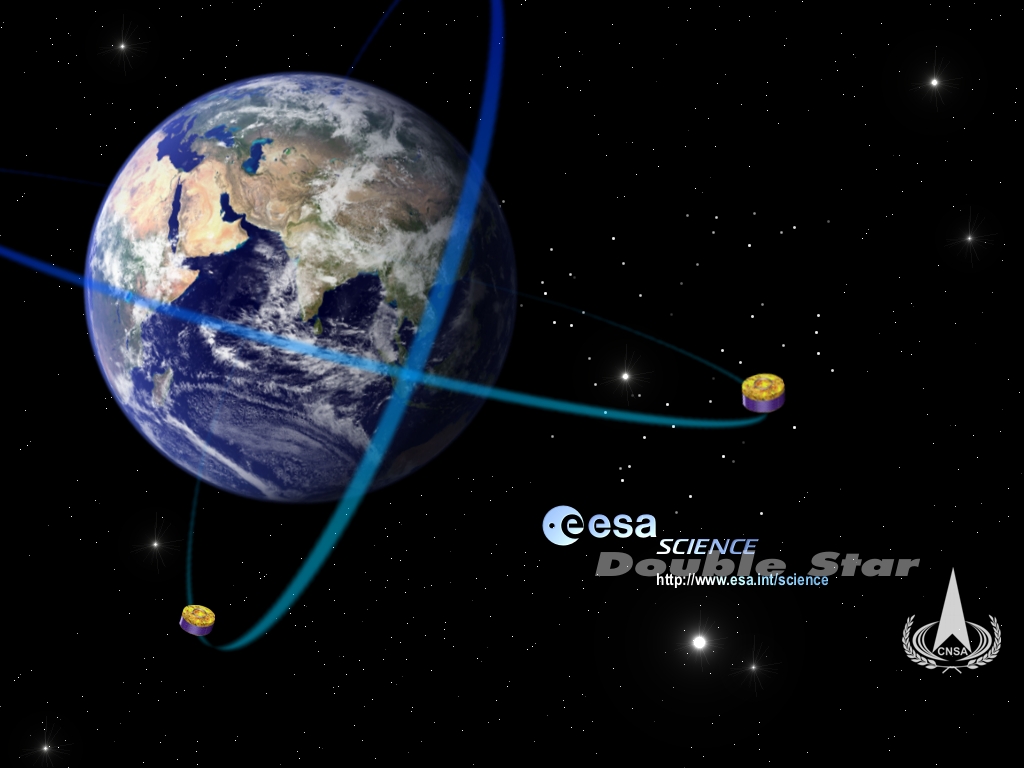


The Double Star Project (DSP) is a joint project between the European Space Agency and the Chinese National Space Administration that will extend our knowledge of the EarthĂs magnetosphere. It comprises two Chinese-built Tan Ce (Explorer) spacecraft:
Double Star will therefore provide new measurements in key regions of the magnetosphere. But the key benefit that Double Star will bring to magnetospheric science is that the orbits of the two spacecraft are explicitly designed for coordinated measurements with ESAĂs ground-breaking Cluster mission. Double Star and Cluster will make simultaneous observations when in separate but related regions. By exploiting such measurements, scientists will improve their understanding of the magnetosphere much better than from either mission alone. A prime example will be when Double Star observes in the reconnection region on the dayside of the magnetosphere while Cluster observes in the so-called ˘cusp÷ region, where it can detect plasma flowing deep into the EarthĂs magnetosphere after entering the magnetosphere in the reconnection region.
Double Star is the first major collaboration between Europe and China on a scientific space mission. Thus a major challenge has been to compare the methods used to develop space missions in Europe and China and to develop ways of working together. It is potentially a very cost effective project for European scientists because a modest European investment (8 million Euros) combined with major Chinese investment has given us a project that could have cost a hundred million Euros or more.
The two spacecraft will be launched from China roughly six months apart on separate Long March 2C rockets. The TC-1 spacecraft is now ready and launch is planned for late December. Whichever day is selected, the launch will take place mid-evening UK time (around 19:30). This is just before dawn at the launch site. This time is set by the need to launch TC-1 into an orbit with apogee in a direction from the Earth that is similar to the direction of the apogees of the Cluster orbits. The launch of TC-2 is due in the summer of 2004. The two spacecraft carry a total of sixteen scientific instruments ű eight from China and eight from Europe.
The coordination of Double Star with Cluster extends to the reuse of many Cluster ideas: (a) seven of the eight European instruments on the two DSP spacecraft are copies of instruments on Cluster, (b) the re-use of the Cluster science operations centre to coordinate operation of the European payload, and (c) re-use of Cluster software for dissemination of data products. Most importantly, the European teams working on Double Star are largely drawn from the Cluster teams and thus have a long and successful history of working together.
DSP will draw on science operations expertise at the Rutherford Appleton Laboratory (RAL). RAL has been running the Cluster Joint Science Operations Centre (JSOC) with great success since the beginning of 2001 and has adapted this to provide a similar service for DSP as the European Payload Operations Service (EPOS). The EPOS will work with the European instrument teams on DSP to coordinate the commanding of their instruments and will deliver the finalised commands to the Double Star Science Application System at the the Chinese Center for Space Science and Applied Research (CSSAR) in Beijing.
As the launch of TC-1 draws near, much attention is now being given to the planning of coordinated measurements by Cluster and DSP. The JSOC team at RAL has a key role here as they are responsible for Cluster planning and therefore are liaising with Chinese colleagues responsible for DSP planning to optimise opportunities for the two missions to make novel scientific observations together.
RAL is also providing the Double Star Data Management System (DDMS) and the Double Star Data System quick-look facility (DSDSweb). The DDMS is an adaptation of the equivalent Cluster system and will exchange key data products between national data centres in Austria, France and the UK and will allows users to browse and retrieve the data. The DSDSweb is also derived from the equivalent Cluster system and will provide a quick-look (within a few days) of selected science data via a web-based system.
UK teams also play a major role in provision of instruments for Double Star as they do for Cluster. Copies of the three UK-led instruments on Cluster will all fly on Double Star:
Last updated 19 December 2003 by Mike Hapgood